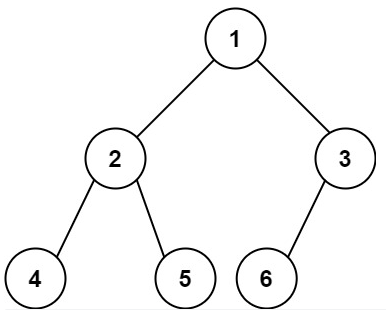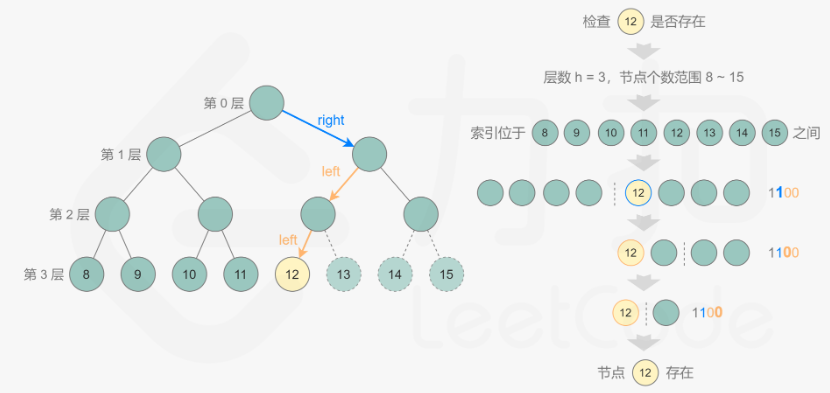题目
给你一棵 完全二叉树 的根节点 root ,求出该树的节点个数。
完全二叉树 的定义如下:在完全二叉树中,除了最底层节点可能没填满外,其余每层节点数都达到最大值,并且最下面一层的节点都集中在该层最左边的若干位置。若最底层为第 h 层,则该层包含 1~ 2^h 个节点。
示例 1:
输入:root = [1,2,3,4,5,6]输出:6
示例 2:
输入:root = []输出:0
示例 3:
输入:root = [1]
输出:1
提示:
- 树中节点的数目范围是
[0, 5 * 10^4] 0 <= Node.val <= 5 * 10^4-
解题方法
递归遍历
递归计算二叉树节点数目,递归终止条件是当前节点为
NULL,此时返回0,否则返回左子树节点数+右子树节点数+1
时间复杂的O(n),空间复杂度O(logn)
C++代码:/** * Definition for a binary tree node. * struct TreeNode { * int val; * TreeNode *left; * TreeNode *right; * TreeNode() : val(0), left(nullptr), right(nullptr) {} * TreeNode(int x) : val(x), left(nullptr), right(nullptr) {} * TreeNode(int x, TreeNode *left, TreeNode *right) : val(x), left(left), right(right) {} * }; */ class Solution { public: int countNodes(TreeNode* root) { if(!root) return 0; int left = countNodes(root->left); int right = countNodes(root->right); return left + right + 1; } };迭代
BFS 层序遍历,记录总结点数目。
时间复杂度O(n),空间复杂度额O(n)
C++代码:/** * Definition for a binary tree node. * struct TreeNode { * int val; * TreeNode *left; * TreeNode *right; * TreeNode() : val(0), left(nullptr), right(nullptr) {} * TreeNode(int x) : val(x), left(nullptr), right(nullptr) {} * TreeNode(int x, TreeNode *left, TreeNode *right) : val(x), left(left), right(right) {} * }; */ class Solution { public: int countNodes(TreeNode* root) { queue<TreeNode*> nodes; int num = 0; if(root) nodes.push(root); while(nodes.size()>0) { int size = nodes.size(); for(int i=0; i<size; i++) { num++; if(nodes.front()->left) nodes.push(nodes.front()->left); if(nodes.front()->right) nodes.push(nodes.front()->right); nodes.pop(); } } return num; } };二分查找
根据完全二叉树的性质,可以判断当前节点左右子树的完全二叉树深度,从而更新查找方向。根据节点索引规律更新节点数目。
时间复杂度O((logn)^2),空间复杂度O(1)
C++代码:/** * Definition for a binary tree node. * struct TreeNode { * int val; * TreeNode *left; * TreeNode *right; * TreeNode() : val(0), left(nullptr), right(nullptr) {} * TreeNode(int x) : val(x), left(nullptr), right(nullptr) {} * TreeNode(int x, TreeNode *left, TreeNode *right) : val(x), left(left), right(right) {} * }; */ class Solution { public: int check(TreeNode *cur) { if(!cur) return 0; int num = 1; while(cur) { if(cur->left && cur->right) num++; cur = cur->right; } return num; } int countNodes(TreeNode* root) { if(!root) return 0; TreeNode *cur = root; int num = 1; while(cur) { if(check(cur->left)>check(cur->right)) { cur = cur->right; num = 2*num+1; } else { cur = cur->left; num = 2*num; } } return num-1; } };二分查找+位运算
根据完全二叉树定义,低层元素索引在
[2^h, 2^(h+1)-1]中,在该范围内通过二分查找,判断对应索引的元素是否存在。
索引对应元素的查找通过位运算进行。索引按位由高到低,若是1则代表右节点,若为0则代表左节点。
时间复杂度O((logn)^2),空间复杂度O(1)
C++代码:/** * Definition for a binary tree node. * struct TreeNode { * int val; * TreeNode *left; * TreeNode *right; * TreeNode() : val(0), left(nullptr), right(nullptr) {} * TreeNode(int x) : val(x), left(nullptr), right(nullptr) {} * TreeNode(int x, TreeNode *left, TreeNode *right) : val(x), left(left), right(right) {} * }; */ class Solution { public: bool exits(TreeNode *root, int level, int k) { int bit = 1<<(level-1); TreeNode* cur = root; while(cur && bit>0) { if(k&bit) cur = cur->right; else cur = cur->left; bit = bit>>1; } return cur!=NULL; } int countNodes(TreeNode* root) { if(!root) return 0; TreeNode *cur = root; int level = 0; while(cur->left) { level++; cur = cur->left; } int low = 1<<level; int high = (1<<(level+1))-1; while(low<high) { int mid = low + (high-low+1)/2; if(exits(root, level, mid)) low = mid; else high = mid-1; } return low; } };

